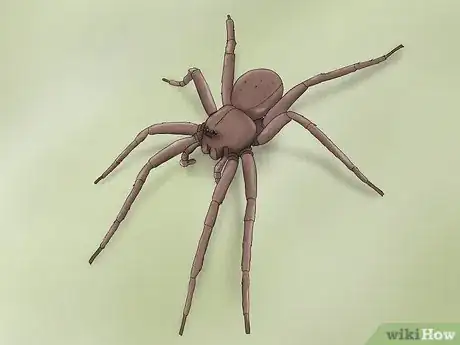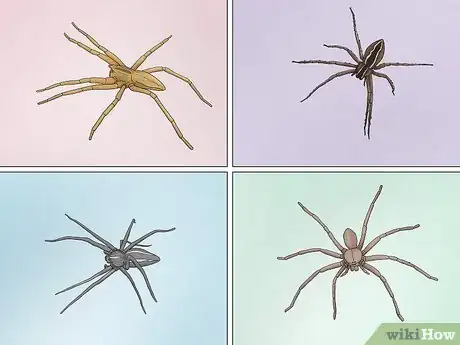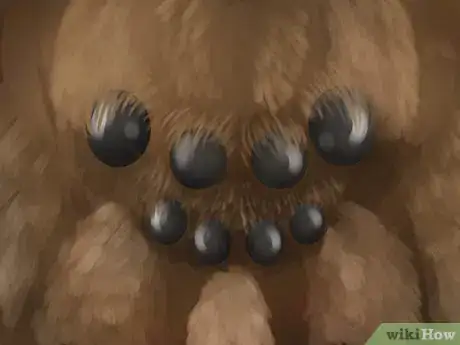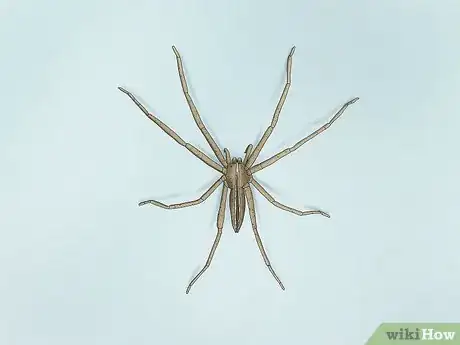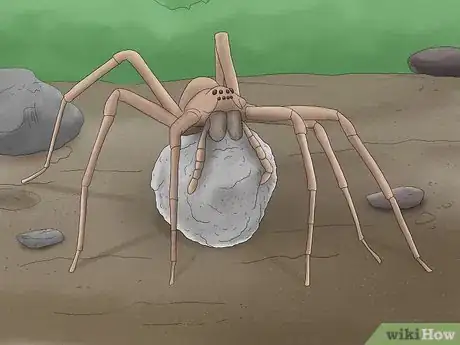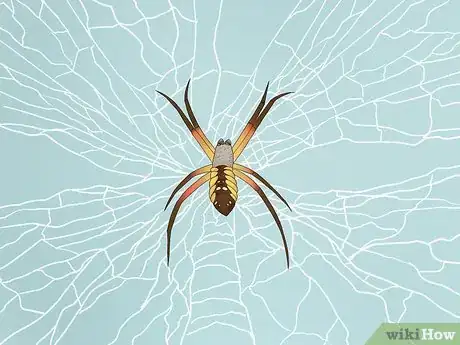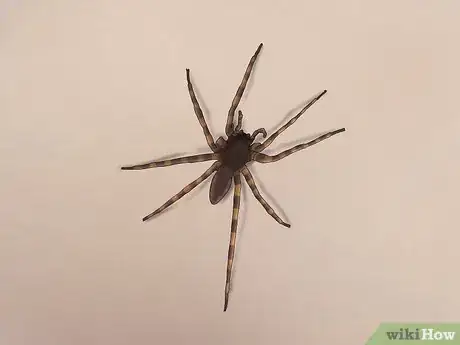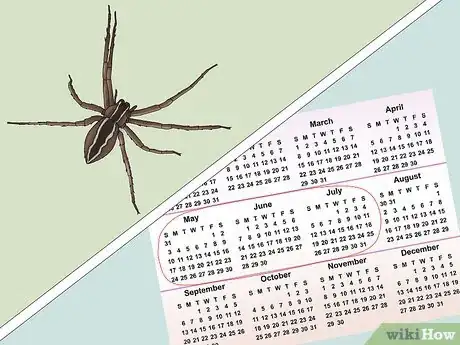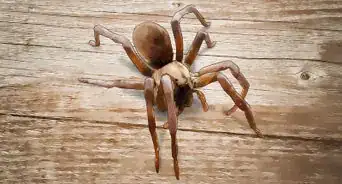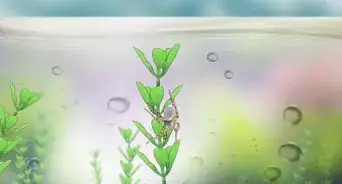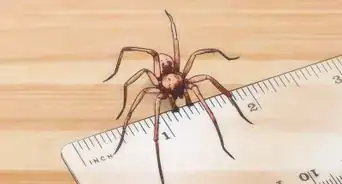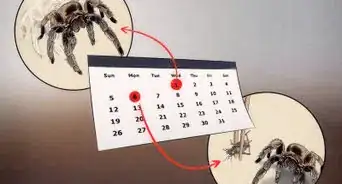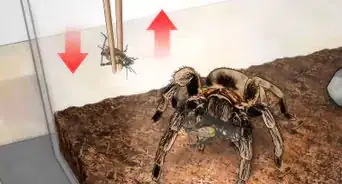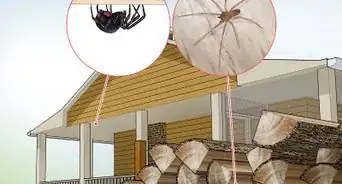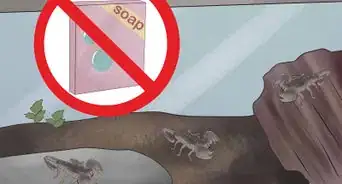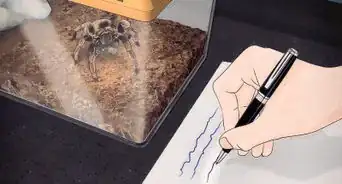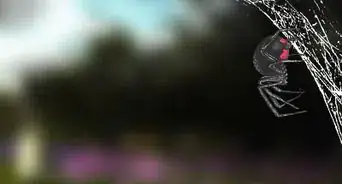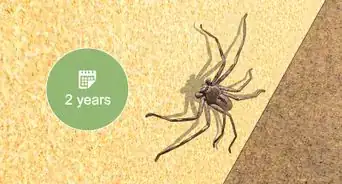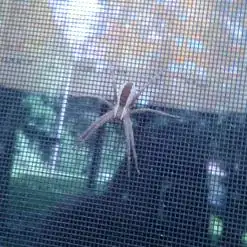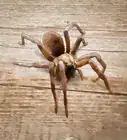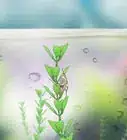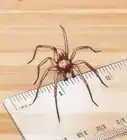This article was co-authored by wikiHow Staff. Our trained team of editors and researchers validate articles for accuracy and comprehensiveness. wikiHow's Content Management Team carefully monitors the work from our editorial staff to ensure that each article is backed by trusted research and meets our high quality standards.
There are 8 references cited in this article, which can be found at the bottom of the page.
wikiHow marks an article as reader-approved once it receives enough positive feedback. This article received 12 testimonials and 94% of readers who voted found it helpful, earning it our reader-approved status.
This article has been viewed 150,002 times.
Learn more...
The nursery web spider (Pisaurina mira) is called so because the female makes a silken nursery web for its young. These common spiders are large and hairy and are often confused with the wolf spider. Their coloration is quite varied compared to most spiders, making them harder to identify than many other species.[1] Still, with a little knowledge and practice, you can identify a nursery web spider.
Steps
Observing the Physical Features
-
1Look for large spiders. The nursery web spider is one of the largest true spiders.[2] They are so big that they are sometimes mistakenly thought to be close relatives of the tarantula.[3]
- The nursery web spider's body is typically about a quarter of an inch to an inch in size, but it may spread its legs out to as far as three inches.[4]
-
2Take note of coloration. Although there are several different variations in coloring, nursery web spiders generally have a base color that is tan, gray, beige, or buff, with darker brown stripes or other markings.[5]
- Close inspection of the legs of these spiders will reveal small black spines sticking out.
Advertisement -
3Examine the spider's eyes. Nursery web spiders have eight eyes. They appear in two horizontal rows. The bottom row is nearly straight, while the top row curves upward forming a "u" shape.[6]
- The eyes of the upper row are somewhat larger than the lower one.
- Examining the eyes, if you can get close enough to do so, is a good way to differentiate between the nursery web spider and the wolf spider, which have a different arrangement of eyes. Specifically, wolf spiders have three rows of eyes.[7]
-
4
Watching Habits and Behaviors
-
1Watch for an egg sac. Possibly the easiest way to identify a female nursery web spider is to watch for any spiders that are carrying an egg sac. A nursery web spider will carry her eggs in her fangs until they are nearly ready to hatch.[10]
-
2Look for a nursery web. When it is almost time for the eggs to hatch, the female spider will spin a protective nursery web. This tangled web is usually spun in high weeds or low shrubs, with the egg sac itself suspended inside a leaf.[13]
- After spinning the nursery web, the mother spider will stand guard over it until the eggs have hatched.[14]
- The nursery web spider will shelter the young spiders until they are ready to fend for themselves.
-
3Watch hunting behavior. Nursery web spiders, unlike many other species, do not spin webs for hunting purposes. Instead, these spiders hide in wait for prey (typically insects) and then spring out quickly to catch it.[15]
- Instead of entangling insects in a web, the nursery web spider simply overpowers and subdues its prey.[16]
- These spiders hunt both by day and by night.
-
4Observe posture. A nursery web spider, while at rest, will often adopt an "X" shaped posture, holding its front and hind pairs of legs together.[17]
Knowing the Nursery Spider's Range and Habitat
-
1Learn the nursery web spider's range. Nursery web spiders are quite common across much of North America. They are most commonly found in the eastern part of the US and southeastern Canada.[18]
- People disagree about how far west these spiders can be found. Some say they have been found all the way out in the states of the West Coast.[19] Others disagree. It is safe to say, however, that they are less common in western states and provinces.
-
2Look for them in their normal habitats. You can look for nursery web spiders in a variety of different types of habitats. They are often found near water.[20] They are known to inhabit the following areas:
- Woodlands
- Farms and gardens
- Grasslands and heaths
- Old fields
- Rocky areas along the edge of streams and other water
-
3Watch for them in the right season. Nursery web spiders mature in late spring and reproduce in the summer.[21] They are most often seen between the beginning of May and the end of July.[22]
- Juvenile spiders will hide under loose bark or rocks in the fall and will remain there for protection during the winter. They will emerge in the spring mature.
- Like most spiders, the lifecycle of this spider is about year.
Community Q&A
-
QuestionAre they dangerous or poisonous?
 Community AnswerUsually not. But a female spider is very protective of her eggs, and may bite if she feels threatened, which will cause a large and painful bump.
Community AnswerUsually not. But a female spider is very protective of her eggs, and may bite if she feels threatened, which will cause a large and painful bump. -
QuestionI have been watching a female nursery web spider in my garden for weeks. She has been carrying her egg sack for longer than a week. How much longer will it be until the babies hatch? Will she die after the babies leave?
 Vincent SherloyCommunity AnswerThe time of death after a hatching depends on the species of nursery web spider. As for how long until the eggs hatch, she will create her enclosure for the eggs around a day or two before they start to emerge from the sac.
Vincent SherloyCommunity AnswerThe time of death after a hatching depends on the species of nursery web spider. As for how long until the eggs hatch, she will create her enclosure for the eggs around a day or two before they start to emerge from the sac. -
QuestionAre they ever purple?
 Community AnswerYes.
Community AnswerYes.
Warnings
- Nursery web spiders are not aggressive to humans, but the female guards her egg sac ferociously, so interfering or tampering with it could result in a bite.⧼thumbs_response⧽
- A nursery web spider bite is likely to be large and painful due to the size of this spider. However, it is not considered dangerous.[24]⧼thumbs_response⧽
References
- ↑ https://spiderid.com/spider/pisauridae/pisaurina/mira/
- ↑ https://www.stlzoo.org/animals/abouttheanimals/invertebrates/spidersandscorpions/nurserywebspider/
- ↑ http://www.uky.edu/Ag/CritterFiles/casefile/spiders/fishing/pisaurid.htm
- ↑ http://www.britannica.com/animal/nursery-web-spider
- ↑ https://spiderid.com/spider/pisauridae/pisaurina/mira/
- ↑ https://spiderid.com/spider/pisauridae/pisaurina/mira/
- ↑ https://spiderid.com/spider/lycosidae/hogna/carolinensis/
- ↑ https://www.wildlifetrusts.org/wildlife-explorer/invertebrates/spiders/nursery-web-spider
- ↑ https://spiderid.com/spider/pisauridae/pisaurina/mira/
- ↑ http://www.insectidentification.org/insect-description.asp?identification=Nursery-Web-Spider
- ↑ http://www.britannica.com/animal/nursery-web-spider
- ↑ http://www.insectidentification.org/nursery-web-spider.asp
- ↑ http://www.insectidentification.org/insect-description.asp?identification=Nursery-Web-Spider
- ↑ http://www.britannica.com/animal/nursery-web-spider
- ↑ https://www.wildlifetrusts.org/wildlife-explorer/invertebrates/spiders/nursery-web-spider
- ↑ https://spiderid.com/spider/pisauridae/pisaurina/mira/
- ↑ https://spiderid.com/spider/pisauridae/pisaurina/mira/
- ↑ https://spiderid.com/spider/pisauridae/pisaurina/mira/
- ↑ http://www.insectidentification.org/insect-description.asp?identification=Nursery-Web-Spider
- ↑ http://www.britannica.com/animal/nursery-web-spider
- ↑ https://spiderid.com/spider/pisauridae/pisaurina/mira/
- ↑ https://www.wildlifetrusts.org/wildlife-explorer/invertebrates/spiders/nursery-web-spider
- ↑ http://www.uky.edu/Ag/CritterFiles/casefile/spiders/fishing/pisaurid.htm
- ↑ http://www.uky.edu/Ag/CritterFiles/casefile/spiders/fishing/pisaurid.htm
About This Article
To identify a nursery web spider, take note of the size and color of the spider you're looking at. If it's leg span is around 3 inches and it's tan, gray, beige, or buff with dark brown stripes, there's a good chance it's a nursery web spider. You can also tell if the spider you're looking at is a nursery web spider by examining its body shape. If the spider is thin with long, slender legs, it could be a nursery web spider. To learn how to identify a nursery web spider by looking at its eyes, scroll down!
